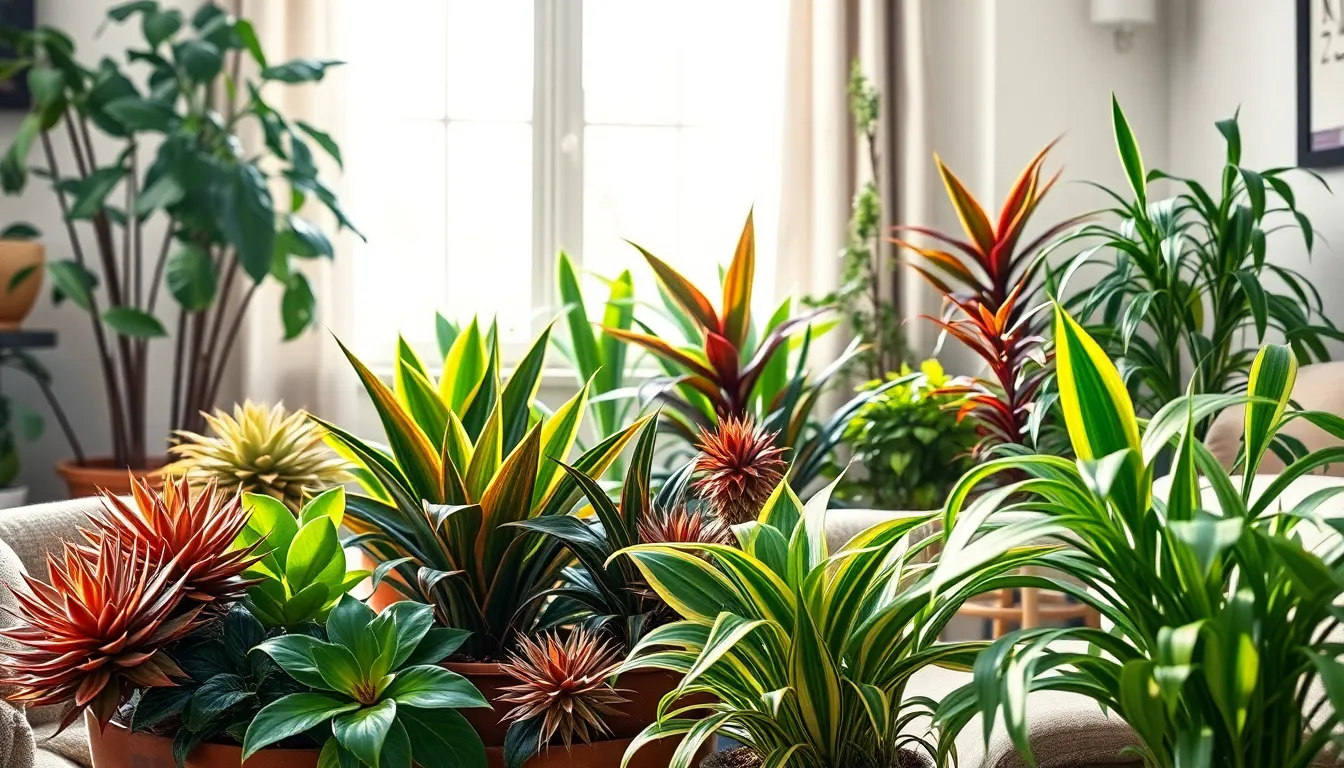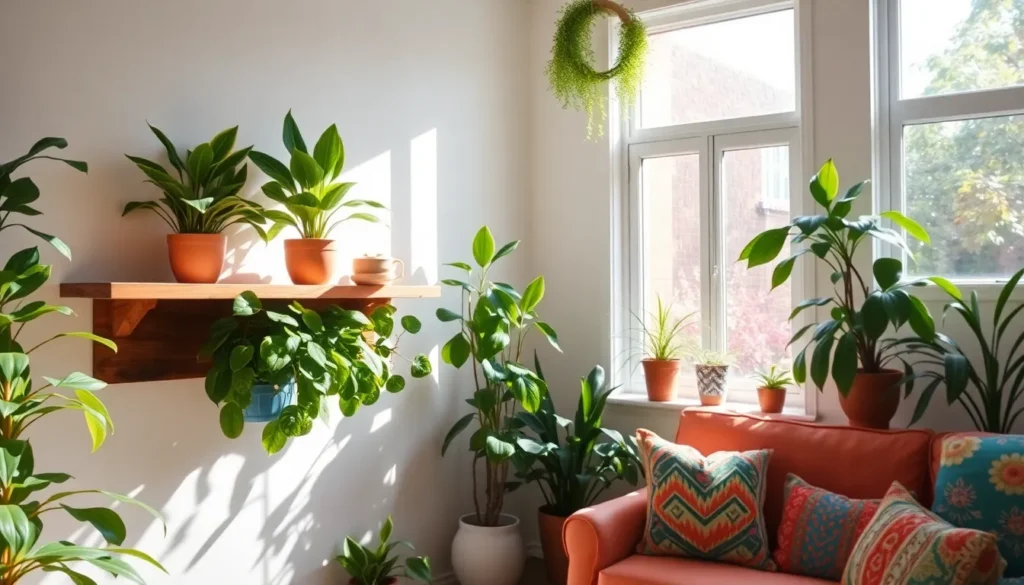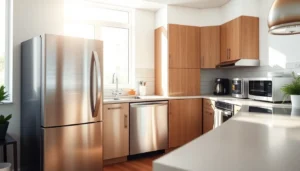Table of Contents
ToggleBringing a touch of greenery into a home can transform a dull space into a vibrant oasis. Good house plants not only beautify a room but also purify the air and boost mood. Imagine walking into your living room and being greeted by the cheerful presence of a leafy friend—it’s like having a pet that doesn’t require feeding or walks!
Benefits Of Good House Plants
Good house plants offer numerous advantages that positively impact home environments. They contribute to improved air quality, enhanced aesthetics, and overall well-being.
Improved Air Quality
Plants actively purify indoor air by absorbing toxins and releasing oxygen. Studies show that house plants can reduce pollutants like formaldehyde, benzene, and trichloroethylene. NASA’s Clean Air Study identifies specific plants, such as spider plants and peace lilies, as effective air purifiers. Better air quality leads to increased oxygen levels and a healthier living space. Additionally, research indicates that having plants nearby can lower stress levels, making the indoor environment more pleasant.
Enhanced Aesthetic Appeal
House plants serve as striking visual elements within any room. They complement decor by adding color, texture, and life. Diverse plant species create unique focal points, allowing for personalization based on individual style. Including plants improves the overall ambiance and makes spaces feel more inviting. Designers often incorporate greenery in interiors to convey freshness and warmth. With various sizes, shapes, and styles available, homeowners easily find plants matching their tastes.
Popular Types Of Good House Plants

House plants come in many varieties, each offering unique benefits. Some varieties require minimal care, while others enhance indoor air quality significantly.
Low-Maintenance Options
Succulents thrive on neglect, needing only occasional watering. Snake plants tolerate low light and irregular watering, making them ideal for busy individuals. Pothos grows quickly and adapts easily to various light conditions. Rubber plants require little maintenance while providing an impressive aesthetic. ZZ plants excel in tough environments, enduring low light and infrequent watering.
Air-Purifying Plants
Spider plants excel at removing formaldehyde and xylene from the air. Peace lilies stimulate improved air quality by absorbing toxins effectively. Boston ferns combat indoor pollutants, needing regular humidity to thrive. Dracaenas filter out benzene, making them a popular choice for households. Bamboo palm contributes to a healthier environment by eliminating harmful chemicals from indoor spaces.
Care Tips For Good House Plants
Caring for house plants is essential for their growth and longevity. Providing adequate water and light ensures they thrive in indoor environments.
Watering Requirements
Watering frequency varies among different plants. Succulents require less water due to their ability to store moisture, making them ideal for forgetful caretakers. In contrast, tropical plants like peace lilies prefer consistently moist soil. It’s important to check the top inch of soil; if it feels dry, it’s time to water. Always ensure that pots have drainage holes to prevent root rot. Overwatering can be just as harmful, leading to yellowing leaves and wilting.
Light Preferences
Light requirements differ significantly between plant species. Snake plants tolerate low light, making them perfect for dimly lit areas. Conversely, succulents and cacti thrive in bright, direct sunlight. Positioning plants near windows increases their exposure to natural light. Monitoring leaves can indicate if a plant is receiving too little or too much light; leggy or discolored leaves often signal an adjustment is necessary. Grouping plants with similar light needs simplifies care and creates an aesthetically pleasing display.
Common Issues With House Plants
House plants can experience various issues that may hinder their growth. Identifying these problems early on ensures healthy plants.
One common issue is overwatering, which can lead to root rot. Signs of overwatering include yellowing leaves and a mushy stem. Ensuring pots have proper drainage prevents this problem.
Underwatering presents another challenge, manifesting in wilted leaves and dry soil. Checking the top inch of soil can help determine moisture levels; if it’s dry, it’s time to water.
Pests pose a significant threat to house plants. Common pests include spider mites, aphids, and mealybugs. Recognizing small webs or sticky residue can indicate an infestation. Regularly inspecting leaves helps catch these pests early.
Nutrient deficiencies affect plant vigor. Yellowing leaves often signify a lack of nitrogen, while brown leaf edges may indicate insufficient potassium. Fertilizing with a balanced house plant fertilizer every few months provides essential nutrients.
Improper lighting conditions also contribute to plant stress. Insufficient light can result in leggy growth, while direct sunlight may scorch leaves. Assessing the light requirements of each plant type ensures they receive optimal exposure.
Temperature fluctuations create stress for house plants as well. Many species prefer temperatures between 65°F and 75°F. Keeping plants away from drafts or heating vents helps maintain a stable environment.
Maintaining humidity levels is crucial for tropical plants, which thrive in higher humidity. Dry indoor air can lead to browning leaf tips. Using a humidifier or placing a tray of water near plants increases humidity levels effectively.
Addressing these common issues promotes thriving house plants, enriching both decor and indoor air quality.
Integrating house plants into home decor offers a unique blend of beauty and health benefits. These resilient companions not only brighten up spaces but also play a vital role in purifying the air. With a variety of options available, anyone can find the perfect plant to suit their lifestyle and aesthetic preferences.
By understanding their care requirements and addressing common growth issues, individuals can ensure their plants thrive. Ultimately, the presence of greenery transforms living spaces into healthier and more inviting environments. Embracing house plants is a simple yet impactful way to enhance both decor and well-being.







